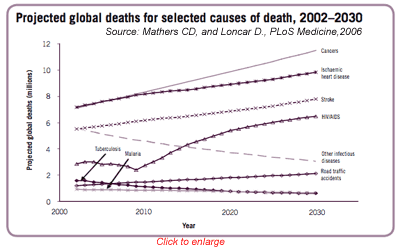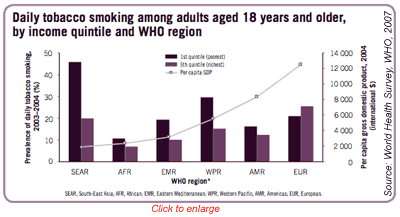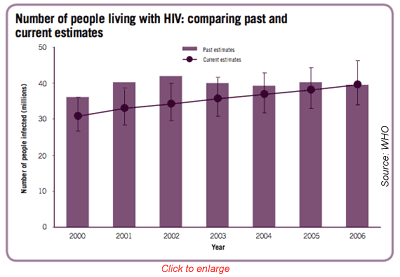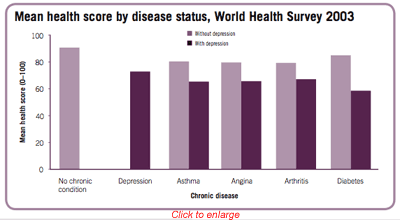Center for Communications, Health and the Environment

Shifts in Global Disease, Death Linked to Lifestyle, Income
In 2004, the world spent a total of Intl $4.9 trillion on health. But the geographical distribution of these financial resources was uneven, and it continues to remain so, according to the World Health Organization's National In the recently published World Health Statistics 2007, the World Health Organization (WHO) projects that the world will experience a substantial shift in the proportion of deaths from communicable to noncommunicable diseases (and from younger to older age groups) during the next 25 years. Thanks to medical advances and widespread vaccination programs, large declines in mortality have already occurred and are anticipated to continue between now and 2030 for all principal communicable, maternal, perinatal and nutritional causes. The only exception to this is HIV/AIDS, global deaths from which are expected to more than double, despite increased awareness and antiretroviral drug coverage.
In addition to HIV/AIDS, the leading causes of death globally in 2030 are projected to be noncommunicable conditions: ischaemic heart disease, cerebrovascular disease (stroke) and chronic obstructive pulmonary disease. Cancers will top the list, accounting for a projected 11+ million global deaths (see chart). Overall, noncommunicable diseases will comprise almost 70 percent of all deaths in 2030 under the baseline scenario, spurred by urbanization, increasingly sedentary lifestyles and the graying of the global population.
Meanwhile, the total number of tobacco-attributable deaths is projected to rise from 5.4 million in 2005 to 6.4 million in 2015 to 8.3 million in 2030. Tobacco is expected to kill 50 percent more people in 2015 than HIV/AIDS and to be responsible for 10 percent of all deaths worldwide.
Three of the 10 causes of mortality highlighted in the World Health Statistics 2007 are briefly discussed below.
Tobacco, Poverty and Mortality
The burden of disease attributable to tobacco use weighs increasingly heavily on the world in general, and on populations in developing economies in particular. According to the latest estimates, more than 80 percent of the 8.3 million deaths attributed to tobacco and projected to the year 2030 will occur in low-income and middle-income countries.
Unfortunately, data on the prevalence of smoking among adults in developing countries are limited. The results of WHO's 2003–2004 World Health Survey, however, indicate that daily tobacco smoking among adults aged 18 and older is most prevalent among the lowest-income households in developing economies – that is, among the poorest of the poor (see chart). Indeed, prevalence is highest among the poor in all WHO regions except the European Region, where high smoking culture and price may be key determining (and discouraging) factors. The difference in prevalence between the poor and the (relatively) rich is greatest among the group of South-East Asian countries surveyed, where average per capita income is lowest.
While developing countries and their impoverished populations are practically force-fed tobacco and its deleterious effects, they are often denied access to much-needed healthcare and global health resources. This combination of a higher prevalence of tobacco use and more limited access to health resources results in severe health inequalities. In fact, these disparities serve to perpetuate the vicious circle of illness and poverty that plagues these already struggling economies. This unfortunate situation has implications for health systems at all levels and underlines the need for additional resources to raise awareness of the dangers of tobacco use among targeted populations, while ensuring them more equitable access to global health resources and preventative care.
HIV/AIDS
With the impact of tobacco looming large, global deaths from HIV/AIDS are projected to rise from 2.8 million in 2002 to 6.5 million in 2030 under a baseline scenario that assumes antiretroviral drug coverage reaches 80 percent by 2012.
The exact number of people living with HIV is undetermined, but we know it is substantial, with current estimates putting the number around 40 million (see figure). The bars in the figure approximate the number of people infected with HIV at the time of publication of each annual AIDS epidemic update since 2000. The line shows the best estimates for each year that were made in 2006 (the most recent update), revealing not only that the size of the epidemic had been previously overestimated but also that it is still growing.
As we are able to achieve more accurate data, we may begin to understand the full extent of the HIV and AIDS epidemic. In the meantime, the world must view HIV/AIDS as a continuing and serious threat. It must also see HIV/AIDS as a target for global health resources, with more than an eye towards allocation, since the majority of HIV/AIDS sufferers live in sub-Saharan Africa and are victims of the same healthcare inequities that surround tobacco.
The Mind-Body Connection
Lack of resources negatively impacts the health of people with chronic diseases. So does depression. In fact, depression affects all chronic illnesses and is a considerable global public health problem due to its relatively high lifetime prevalence and the significant disability that it causes.
In 2002, depression accounted for 4.5 percent of the worldwide total burden of disease (in terms of disability-adjusted life years). It is also responsible for the greatest proportion of burden attributable to non-fatal health outcomes, accounting for almost 12 percent of total years lived with disability worldwide, according to WHO. Without treatment, depression has the tendency to assume a chronic course, to recur, and to be associated with increasing disability over time.
According to WHO's World Health Survey, individuals 18 years and older without depression and without other chronic conditions score higher on health, with a mean health count of 90 out of a top score of 100 (see figure). Adults with only one chronic disease tend to come in lower, around 80, while those with depression but no chronic diseases score around 73. Individuals with depression and another chronic condition produce much lower mean health scores when compared with those who have only a chronic condition. These patterns were consistent after adjusting for socio-demographic variables.
This analysis does not indicate whether people are more depressed because they have a coexisting chronic condition; however, it is clear that the timely diagnosis and treatment of depressive disorders are essential, irrespective of causality. In many primary care settings, when patients present with multiple disorders that include depression, the depression often remains undiagnosed, or, if it is diagnosed, treatment usually focuses on the other chronic diseases.
Thankfully, depression can be treated in primary care or community settings using locally available and cost-effective interventions, which means that detection and diagnosis are the keys to helping eliminate depression and its deleterious effects from the healthcare equation.
Contributing Causes
A number of other conditions and diseases contribute to the worldwide disease burden and distribution of global deaths. Undernutrition, for example, continues to plague developing countries. Based on WHO's new Child Growth Standards (http://www.who.int/childgrowth/en), the global estimate of wasting (defined as being –2 standard deviations below the median of weight-for-height) among children under 5 years of age is 10 percent, or 55 million, with 29 million of these estimated to live in south–central Asia. The same regional pattern is found for severe wasting (defined as being –3 standard deviations below the median), with an estimated total prevalence of 4 percent, or 19 million children affected. Many of these children are likely to die before reaching the age of 5.
Although incidence rates are now stable or falling in all WHO regions, tuberculosis (TB) remains a serious health threat. An estimated 8.8 million new TB cases occurred in 2005, including 7.4 million in Asia and sub-Saharan Africa , and 1.6 million people died of the disease, including 195,000 patients infected with HIV.
The global burden of TB is not falling fast enough to satisfy the more demanding targets set by the Stop TB Partnership. At the current pace, 1990's prevalence and mortality rates will not be halved worldwide by 2015 as ambitiously projected. Further strides are necessary in case detection and cure, and major efforts are needed to boost collaborative activities between TB and HIV programs.
Conclusion
WHO's World Health Statistics 2007 makes clear that there are substantial health inequities among populations with different socioeconomic or demographic characteristics. In part, this is because richer countries with smaller populations and lower disease burdens use many more health resources than do poorer countries with larger populations and higher disease burdens. Furthermore, the rising global death toll from noncommunicable diseases disproportionately affects older age groups – and poorer ones – that are more susceptible to chronic conditions and less likely to receive the necessary treatment or aid for prevention. Thus, there is an absolute need for additional resources for many poorer countries, as well as a need to reassess the efficiency of spending on health in richer countries.
WHO points out that it is crucial for the international community to invest in better data collection; valid, reliable and comparable use indicators; and well-defined strategies for monitoring progress and evaluating health programs. Finally, to allow poor nations a fighting chance towards reducing the global disease burden and lowering global deaths due to preventable factors, international leaders must give high priority to primary prevention programs and public education in poorer nations.
Click here to read: Lead Article | Companion Article

Dr. Sushma Palmer, Program Director
Valeska Stupak, Editorial & Design Consultant
Shiraz Mahyera, Systems Manager
Rohit Tote, Website Consultant



